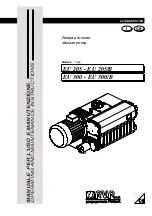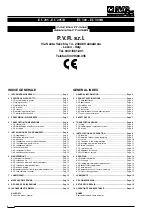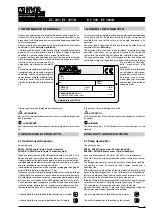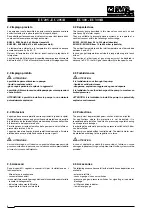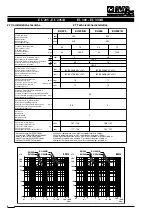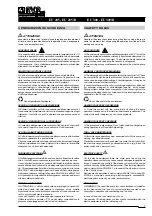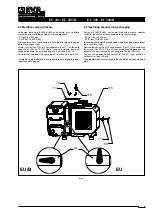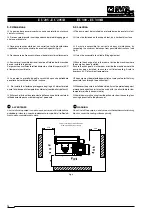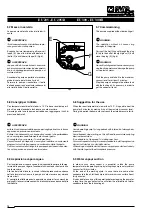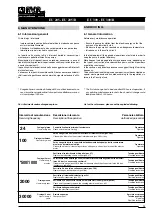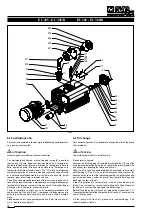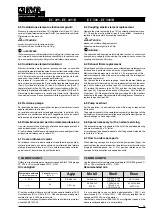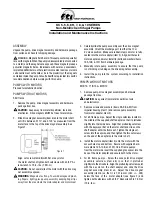
EU 205 - EU 205/B EU 300 - EU 300/B
s.r.l.
pompe per vuoto
12
5.7 Messa in servizio
La pompa viene fornita priva di olio lubrifi-
cante.
AVVERTENZE
:
il funzionamento senza olio lubrificante pro-
voca grossi danni alla pompa.
Eseguire il primo riempimento attraverso il
tappo (E) sino alla metà dell'indicatore di
livello (F) e richiudere il tappo (E) (
fig.6).
AVVERTENZE
:
una quantità d'olio superiore al necessario
può provocare un intasamento dei separatori
olio e un danneggiamento alla pompa o al
motore elettrico.
Accendere la pompa e portarla al massimo
grado di vuoto per almeno 2 minuti.
Fermare la pompa, ricontrollare il livello
d'olio ed eseguire un'eventuale rabbocco di
olio ripristinando il livello corretto.
5.8 Consigli per l'utilizzo
Con temperature ambiente inferiori a 10
°
C è bene riscaldare per 5
minuti la pompa facendola funzionare a vuoto massimo.
Durante questa fase la pompa potrebbe non raggiungere i limiti di
pressione dichiarati.
AVVERTENZE
:
evitare il funzionamento della pompa per lunghi periodi con la bocca
aspirazione a pressione atmosferica.
Evitare il funzionamento con frequenti accensioni che porterebbero
ad un'usura precoce dell'elemento elastico del giunto.
Si consiglia di non superare i 10 avviamenti/ora.
Per avviamenti più frequenti si consiglia di adottare un avviamento
progressivo (soft starter) oppure un avviamento stella triangolo.
Con l’avviamento stella triangolo la pompa può partire esclusivamen-
te con l’aspirazione a pressione atmosferica.
5.9 Aspirazione vapor acqueo
Per l'aspirazione di vapor acqueo è indispensabile portare la tempe-
ratura della pompa a regime, facendola funzionare per trenta minuti a
vuoto massimo.
Alla fine del ciclo di lavoro, in caso di ulteriore presenza di condensa
nell'olio lasciare funzionare la pompa a vuoto massimo per almeno
trenta minuti.
E' consigliato effettuare questa operazione prima di fermi macchina
prolungati; lo zavorratore consentirà di eliminare le condense dall'olio
lubrificante.
5.7 Commissioning
The pump is supplied without lubricating oil.
WARNING:
The operation without oil causes big
damages to the pump.
Carry out the first filling up through the plug
(E) up to the half of the sight glass (F) and
close the plug (E) (fig.6).
WARNING:
A quantity of oil greater than necessary may
clog the oil separator and damage the pump
or the electric motor.
Start the pump and take it to the maximum
vacuum level for at least 2 minutes.
Stop the pump, check again the oil level and
add the lacking oil, if necessary, in order to
get the correct oil level.
5.8 Suggestion for the use
When the room temperature is lower than 10
°
C, it is good to heat the
pump for 5 minutes by making it run at the maximum vacuum level.
During this period the pump may not reach the stated pressure limits.
WARNING:
Avoid operating pump for long periods with inlet port at atmospheric
pressure.
Avoid frequent stop-starting, as this will lead to premature coupling
elastic element wear.
It is advisable not to exceed 10 startings per hour.
For more frequent starting, it is recommended to install a progressive
starter (soft starter) or a star/delta starter.
When using a star/delta starter, the vacuum pump can start exclusively
with the inlet against the atmospheric pressure.
5.9 Water vapour suction
In order to suck water vapour it is essential to take the pump
temperature to its operating value, by letting the pump run at maximum
vacuum for thirty minutes.
At the end of the working cycle, in case there are some other
condensate in the oil, let the pump run at maximum vacuum for at least
thirty minutes.
It is advisable to carry out this operation before stopping the pump for
a long time; the gas ballast valve will allow the elimination of water
condensate from the lubricating oil.
Fig.6
E
F
G

